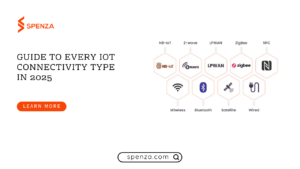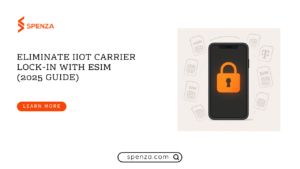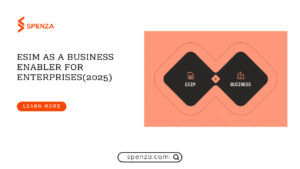In today’s hyper-connected world, businesses must make a critical decision: should they use standard SIM cards or embrace cutting-edge eSIM technology? With connectivity serving as the backbone of company operations, your choice can have a substantial impact on efficiency, costs, and environmental footprint. Dive into this detailed guide to determine which choice is best for your company—and how Spenza can make the transition to eSIM simple and useful.
Understanding Traditional SIMs
What is a Traditional SIM? Why are they still relevant?
A traditional SIM card is a small, removable chip that stores data such as your phone number, contacts, and network authentication information. It is inserted into a slot in your device to connect to a mobile network.
People still use traditional/physical SIM cards because they are widely supported by almost all mobile devices and offer a tangible sense of control over network connectivity. Additionally, traditional SIMs are easy to switch between devices, making them a reliable option for those who frequently upgrade or change their phones.
Benefits of Traditional SIMs
- Easy to Switch Devices: Traditional SIMs can be easily removed and inserted into another device, making it simple to switch phones while retaining your number and data.
- Widely Supported: Almost all mobile devices support traditional SIM cards, ensuring compatibility across a broad range of devices.
- Physical Control: Having a physical SIM card gives users a tangible sense of control over their network connectivity.
Drawbacks of Traditional SIMs
- Size and Durability: Traditional SIMs are small and can be easily lost or damaged.
- Limited Flexibility: Switching networks or plans often requires obtaining a new SIM card, which can be inconvenient.
- Environmental Impact: The production and disposal of physical SIM cards have environmental implications.
Did You Know?
- Traditional SIM cards date back to the early 1990s and have evolved from credit card-sized chips to nano-SIMs.
- The sim card was first invented and manufactured in Munich, by smart-card maker Giesecke and Devrient in 1991.
Understanding eSIMs
What is an eSIM? How did this evolution happen?
An eSIM is an embedded SIM card that is integrated into the device’s motherboard. It supports remote provisioning, which means you can transfer networks or plans without physically changing your SIM card. Imagine controlling your company’s whole collection of mobile devices with a few clicks. That’s the power of eSIM.
The evolution of eSIM technology began with the need for more flexible and efficient connectivity solutions, leading to its integration into modern devices and widespread adoption by mobile carriers.
Benefits of eSIMs
- Convenience: eSIMs allow for easy switching between networks and plans. You can change your carrier or plan with a simple phone call or online process, eliminating the need for a physical SIM card
- Multiple Profiles: eSIMs can store multiple SIM profiles, allowing users to switch between different networks or plans easily
- Space Efficiency: Since eSIMs are embedded, they free up space within the device, allowing for larger batteries or other components
- Durability: eSIMs are less prone to physical damage or loss compared to traditional SIM cards
- Environmental Benefits: eSIMs reduce the need for physical SIM cards, which can help minimize electronic waste
Drawbacks of eSIMs
- Limited Compatibility: Not all devices support eSIMs, although this is changing rapidly.
- Carrier Support: Some mobile carriers may not fully support eSIM technology, which can limit your options.
- Initial Setup: The process of setting up an eSIM can be more complex compared to inserting a traditional SIM card.
eSIM vs. Traditional SIMs: A Comparison
| Feature | eSIM (Embedded SIM) | Traditional SIM (Physical SIM) |
|---|---|---|
| Physical Format | Built directly into the device; no removable card is required. | Removable plastic card inserted into the device. |
| Size | Extremely compact; part of the device’s motherboard. | Varies: Standard, Micro, Nano SIM. |
| Switching Networks | Can switch networks remotely without changing hardware. | Requires physical replacement to switch carriers. |
| Installation | Activated via software with a QR code or app. | Inserted physically into the SIM slot. |
| Device Compatibility | Limited to devices with eSIM support (e.g., newer smartphones, IoT devices). | Compatible with most mobile devices, including older models. |
| Security | More secure; tamper-resistant design reduces cloning risks. | Less secure; physical theft or cloning is possible. |
| Convenience | Enables seamless international roaming and profile switching. | Requires purchasing and swapping local SIMs for roaming. |
| Cost | May involve additional costs for setup or device compatibility. | Typically low-cost or bundled with carrier plans. |
| Customization | Managed through apps or carrier platforms for easy updates. | Customization is limited; physical replacement needed for updates. |
| Adoption Trend | Increasing adoption in smartphones, smartwatches, IoT devices. | Traditional option; still widely used but declining in popularity. |
Why eSIMs Are the Future of Business Connectivity
eSIMs are poised to revolutionize business connectivity by offering unparalleled flexibility, convenience, and environmental benefits. Over 4.5 billion physical SIM cards are produced annually, generating tons of plastic waste. Switching to eSIM could drastically cut this number, contributing to a more sustainable future.
In 2023, an estimated 4.5 billion physical SIM cards were produced worldwide, each accounting for an average of 229 grams of CO2 emissions . By adopting eSIMs, businesses can reduce their carbon footprint and align with the United Nation’s Sustainable Development Goals (UN SDGs), enhancing investor confidence and regulatory compliance
eSIMs eliminate the need for physical cards altogether, allowing devices to be easily reconfigured and reused instead of discarded. This extends the lifespan of devices, reduces e-waste, and maximizes their value
Industries Leading in eSIM Adoption
Automotive Industry
The automotive industry is at the forefront of eSIM adoption, particularly for IoT applications. Regulations mandating emergency call (eCall) functionalities are driving eSIM deployments in connected vehicles. By 2030, eSIM is expected to account for 37% of total cellular IoT connections, highlighting its significant role in the automotive sector.
Internet of Things (IoT)
The IoT sector is rapidly adopting eSIM technology due to its numerous benefits, including better security, simplified roaming, and easier provisioning. The installed base of eSIM-capable IoT connectivity modules reached 650 million in 2023, showcasing the technology’s growing prevalence. eSIMs enable remote SIM provisioning, global connectivity, and enhanced security, making them a crucial component for IoT devices.
Remote Workforces
Remote workforces are increasingly benefiting from eSIM technology, which allows for seamless connectivity and flexibility. eSIMs enable remote provisioning and management of SIM profiles, allowing employees to switch networks or plans easily without physical SIM cards.
By adopting eSIM technology, industries such as automotive, IoT, and remote workforces can enhance their operational efficiency, reduce costs, and ensure secure and reliable connectivity. The transition to eSIMs is not just about convenience but also about making a conscious choice for the environment, aligning with broader sustainability goals, and contributing to a greener, more connected world.
Spenza: Your Partner in eSIM Adoption
Spenza is at the forefront of supporting eSIM technology for businesses. Their platform offers automated inventory management, making it easier to track and manage both physical SIM cards and eSIMs. This ensures seamless connectivity and simplifies the process of managing multiple mobile plans and devices
Benefits of Using Spenza for eSIM Management
- Automated Inventory Management: Spenza’s platform simplifies the tracking of physical SIM cards and eSIM management, ensuring seamless connectivity
- Cost-Quality Balance: Spenza helps enterprises achieve a cost-quality balance by optimizing the use of eSIMs and reducing the need for physical SIM inventory
- Environmental Challenges: eSIMs help in addressing environmental challenges like high humidity, temperature, water-resistance, and vibration, making them ideal for various business applications
Conclusion
The choice between eSIMs and traditional SIMs depends on your business needs and priorities. eSIMs offer greater flexibility, convenience, and durability, making them an attractive option for modern businesses. Spenza’s support for eSIM technology further enhances these benefits by providing automated inventory management and cost-quality optimization. As the adoption of eSIMs continues to grow, businesses can expect to see even more advantages in terms of connectivity and efficiency.
Interested in learning more about how Spenza can transform your business with eSIM technology? Contact us today to speak with one of our experts and discover the tailored solutions we offer to meet your specific needs.
FAQS
The main difference is that eSIMs are embedded within the device and allow for remote provisioning, while traditional SIMs are physical cards that need to be inserted into the device.
Yes, eSIMs can store multiple SIM profiles, allowing you to switch between different networks or plans easily.
Spenza’s platform offers automated inventory management, which simplifies the tracking and management of eSIMs. This ensures seamless connectivity and reduces the complexity of handling multiple mobile plans and devices
Yes, Spenza provides comprehensive support for businesses transitioning to eSIM technology. Their platform includes tools for remote provisioning and management of eSIM profiles, making it easy for businesses to switch carriers or plans without the need for physical SIM cards.
Spenza’s eSIM management solution is particularly beneficial for remote workforces. By allowing remote provisioning and management of eSIM profiles, Spenza enables businesses to update and manage employee devices regardless of their location.





